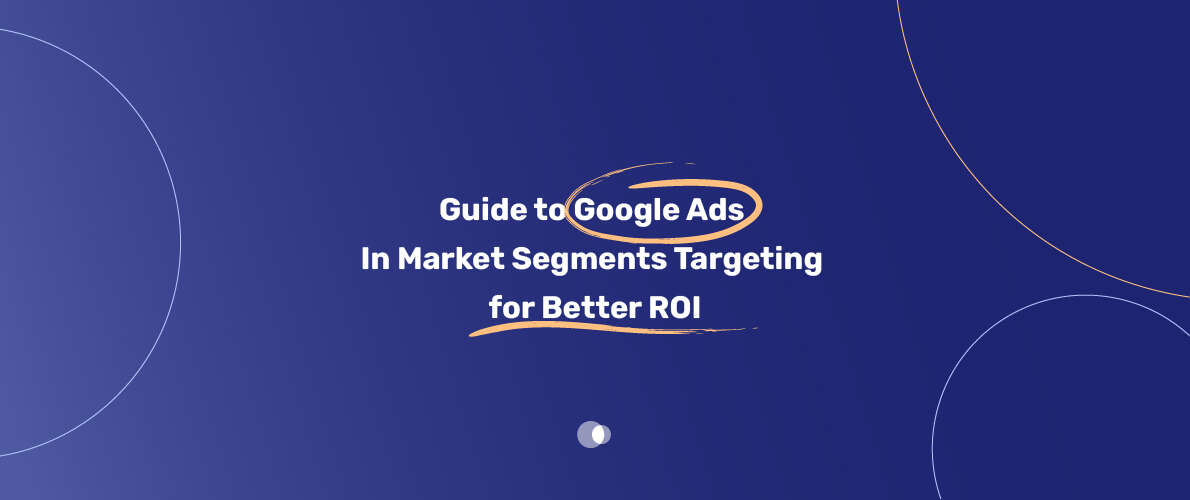Ever wish there was a magic button that could beam your business offer straight to the people who are most likely to buy right now? Well, here’s the next best thing: Google Ads in market segments targeting. If you’re running ads for your business—or your client’s—you’ll want to understand how to wield this tool for bigger returns. Whether you’re a small shop in Tehran, a startup in Berlin, or a Google Ads agency in Dubai, this guide is for you.
Table of Contents
Let’s jump in. But first, a confession: The first time I heard about in-market segments, I thought, “Yeah, right. Like Google really knows what I want to buy.” Fast-forward to today—and seeing my own buying habits neatly anticipated by those eerily relevant ads—I’m a believer. And if you’re looking to squeeze more ROI out of your digital ad spend, you should be curious too.
What Are In-Market Segments in Google Ads?
Okay, let’s break it down. Google Ads in market segments targeting is about finding people who are actively shopping for what you’re selling. Not just those idly scrolling, but folks showing real buying signals. Google lumps them into “in-market” segments by analyzing what they search for, what websites they visit, what apps they use, and even—get this—their offline behavior (thanks to mobile location data).
Think of it as Google’s way of saying: “Hey, this person is looking for a new car, or a pair of running shoes, or maybe a vacation package to Dubai.” If you’ve ever been startled by how quickly ads seem to know what you want… yeah, this is why.
Let’s say you’re an adwords management dubai specialist, and your client sells luxury watches. Instead of targeting everyone who’s ever Googled “watch,” you can zero in on people who’ve been recently researching watch reviews, comparing brands, or checking out luxury gifting guides. That’s laser focus.
Types of Audiences in Google Ads: Where In-Market Fits
To get the big picture, Google divides audiences into four flavors:
- In-market segments (our focus)
- Affinity segments (people with long-term interests—think “car lovers” or “fitness buffs”)
- Detailed demographics (categories like age, marital status, parental status, etc.)
- Life events (big milestones—moving, getting married, starting college…)
Of these, in-market segments are the closest you’ll get to targeting “ready-to-buy” users. It’s not about vague interest; it’s about now.
Campaign Types That Support In-Market Segments
Wondering where you can actually use this targeting? Here’s the rundown:
- Search Campaigns: You can target or observe in-market segments. For example, target “in-market for laptops” if you sell tech gear.
- Shopping Campaigns: Same as above—target or observe.
- Display Campaigns: Directly target or observe.
- Video Campaigns: Particularly handy for YouTube ads—target those actively researching your category.
- Demand Gen Campaigns: Targeting available, but you can’t exclude in-market segments anymore.
- Performance Max Campaigns: Here, in-market audiences act as “signals,” not strict targets.
- Combined Segments: Mix and match for the ultimate customized audience.
And here’s a tip from the trenches: If you’re running Google Ads optimization Dubai projects, don’t just target—set segments to “observation” too. You’ll get valuable data on how these users behave, without limiting your reach.
What If There’s No In-Market Segment for My Category?
Happens more often than you’d think. Google boasts over 1,000 in-market segments, but they don’t cover every niche. I ran into this with a client selling eco-friendly yoga mats—no direct in-market category.
Here’s what I did (and what you should try):
- Go Adjacent: Pick the next-best segment. No “yoga mats”? Try “in-market for fitness equipment.”
- Use Detailed Demographics: Maybe your buyers are “parents of preschoolers” or “active retirees.” These segments can be gold.
- Create Custom Segments: This is a game-changer. Build your own audience based on search terms, websites visited, and apps used. For example, create a custom segment for users who’ve Googled “best eco yoga mats” in the past week. You can use this in Display, Demand Gen, Video, or as a signal in Performance Max.
Limitations (And When In-Market Segments Don’t Work)
It’s not all sunshine and rainbows. In-market segments are awesome for products or services with a longer research phase—think travel, cars, insurance, or B2B software.
But what about things people buy impulsively, or with a short decision window? Let’s say you’re selling umbrellas on a rainy day—by the time Google recognizes someone’s in-market for “umbrellas,” they’ve probably already bought one.
I’ve seen this firsthand with a pharmacy client. We tried targeting “in-market for cold medicine,” but by the time Google’s algorithm caught up, the cold was over! My advice: For short-cycle buys, use broader or adjacent segments, or focus on affinity and custom audiences.
Why Use In-Market Segments? Who Are They Best For?
Let’s get real—if you want conversions (and who doesn’t?), in-market segments are the lowest funnel of Google’s pre-built audiences. That means these are the people closest to handing over their money.
In my experience, brands see higher conversion rates and better cost-per-acquisition when they layer in-market targeting with their keyword targeting. Especially if you’re new to audience strategies, start here before exploring life events, affinity audiences, or custom segments.
And don’t forget to pair this with strong creative. An in-market audience won’t help if your ad looks like it was made in 2003.
Google Ads In Market Segments Targeting: Step-by-Step Setup
Ready to put this into action? Here’s how I usually set up Google Ads in market segments targeting for my clients:
- Log in to Google Ads: Head to your campaign or ad group.
- Click on “Audiences”: In the left-side navigation.
- Choose “Browse” > “What they are actively researching or planning”: This is where in-market segments live.
- Select Your Segment(s): Search or scroll for the most relevant options.
- Apply as Targeting or Observation: Remember, “targeting” narrows your reach, while “observation” collects data.
- (Optional) Build Combined Segments: Layer multiple audience types to create even more precise targets.
- Monitor Performance: Trust me, check in after a few days. Tweak as needed.
If you’re managing Google Ads for a company in Dubai or anywhere else, these steps will help you make the most of your ad spend.
When In-Market Segments Outperform (And When They Flop)
Here’s a personal story. I once ran a campaign for a travel agency specializing in luxury safaris. Targeting “in-market for African travel” blew every other audience out of the water—click-through rates more than doubled, and the cost per lead dropped by 30%. Why? Because these folks were already dreaming about a safari; my ad just nudged them toward a decision.
On the flip side, I’ve seen campaigns tank when the in-market window is too short. For example, when running ads for a flash sale on shoes, the in-market segment was too slow—by the time Google identified the shopper, the sale was over.
Moral of the story: Know your buying cycle. If it’s long, in-market segments rock. If it’s short, supplement with broad targeting or custom segments.
How Do In-Market Segments Compare to Other Audience Types?
Here’s the scoop:
- Affinity Audiences: Great for brand awareness. Not as “ready to buy” as in-market.
- Detailed Demographics: Useful for refining your reach but not intent-heavy.
- Life Events: Good for targeting people going through big changes (moving, marriage, etc.).
- Custom Segments: The ultimate in flexibility—you define who you want.
In-market is your bread-and-butter for high-intent, conversion-focused campaigns.
Google Ads Optimization Services Dubai: Why Local Experience Matters
If you’re in Dubai—or advertising to the Middle East—local market nuances really matter. I’ve seen campaigns flop simply because the in-market segment didn’t account for language, culture, or even the local buying season (like Ramadan or shopping festivals). Instead of rushing to buy Google Ads account access, focus on tailoring your strategy to the region. That’s where real performance begins.
That’s where Google Ads optimization services Dubai come in. A local team knows the ins and outs, from bilingual ad copy to cultural moments that drive purchase intent.
AdWords Management Dubai: Don’t Go It Alone
Look, the Google Ads platform gets more complex every year. Algorithm updates, new campaign types, and policy changes can make your head spin. If you’re managing large budgets, especially in a competitive market like Dubai, you can’t afford rookie mistakes.
That’s why AdWords management Dubai services are so popular. It’s not just about setup—it’s ongoing optimization, troubleshooting, and finding those “aha!” moments in your analytics. And if your account ever gets flagged or suspended, you’ll want pros who know Google Ads account suspension recovery inside out. (Ask me about the time a client’s account was suspended during peak season—fun times.)
Pro Tips for Maximizing In-Market Segments
- Combine with Keyword Targeting: Don’t just rely on audiences—layer them with high-intent keywords.
- Test Multiple Segments: Not sure which in-market group is best? Test several.
- Use Exclusions: If you know a segment is irrelevant (say, “in-market for used cars” when you sell new), exclude it.
- Monitor & Optimize: Watch performance weekly. Adjust bids and budgets for top-performing segments.
- Refresh Your Custom Segments: User behavior changes. Update your custom audiences every few months.
How to Measure Success
Keep an eye on these metrics:
- Conversion Rate: Are in-market segments converting better than others?
- Cost-per-Acquisition (CPA): Is your spend more efficient?
- Click-Through Rate (CTR): Are people engaging with your ads?
- Impression Share: Are you reaching enough of your target audience?
Pro tip: Use Google Analytics to track user journeys from ad click to conversion. This is where those “aha!” moments happen.
Final Thoughts: Is Google Ads In Market Segments Targeting Right for You?
Here’s the thing—I’ve seen businesses transform their ROI by getting smart with Google Ads in market segments targeting. But it’s not a set-it-and-forget-it deal. You need to experiment, analyze, and optimize. Sometimes, you’ll be surprised: an unexpected segment outperforms your main target. Other times, you’ll need to pivot fast.
So, whether you’re a growing e-commerce store, a B2B SaaS startup, or an agency client looking for more bang for your buck, this targeting method is worth your attention.
And if you’re feeling overwhelmed—or just want to see faster, better results—why not let the experts handle it? At Admoon, we specialize in Google Ads optimization, in-market segment targeting, and every flavor of digital advertising. Our team blends data-driven strategy with real-world experience (and more than a few battle scars). Book a free consultation today. Let’s make your Google Ads budget work harder than ever before.



